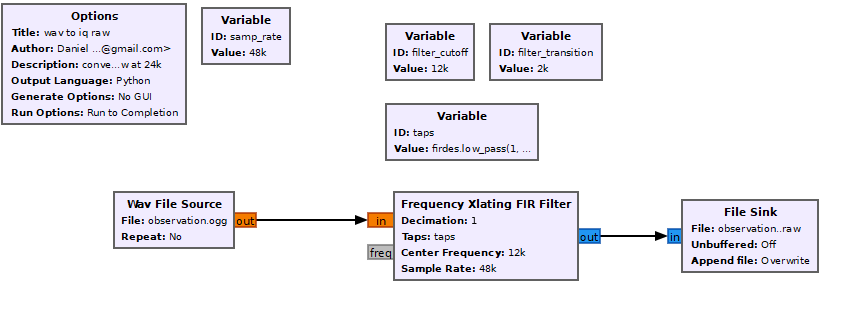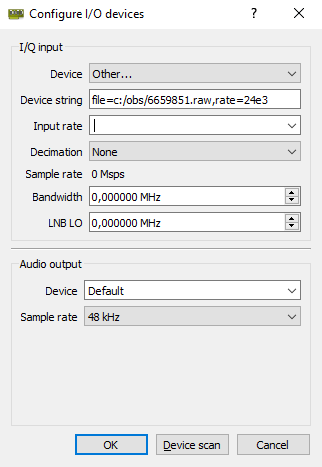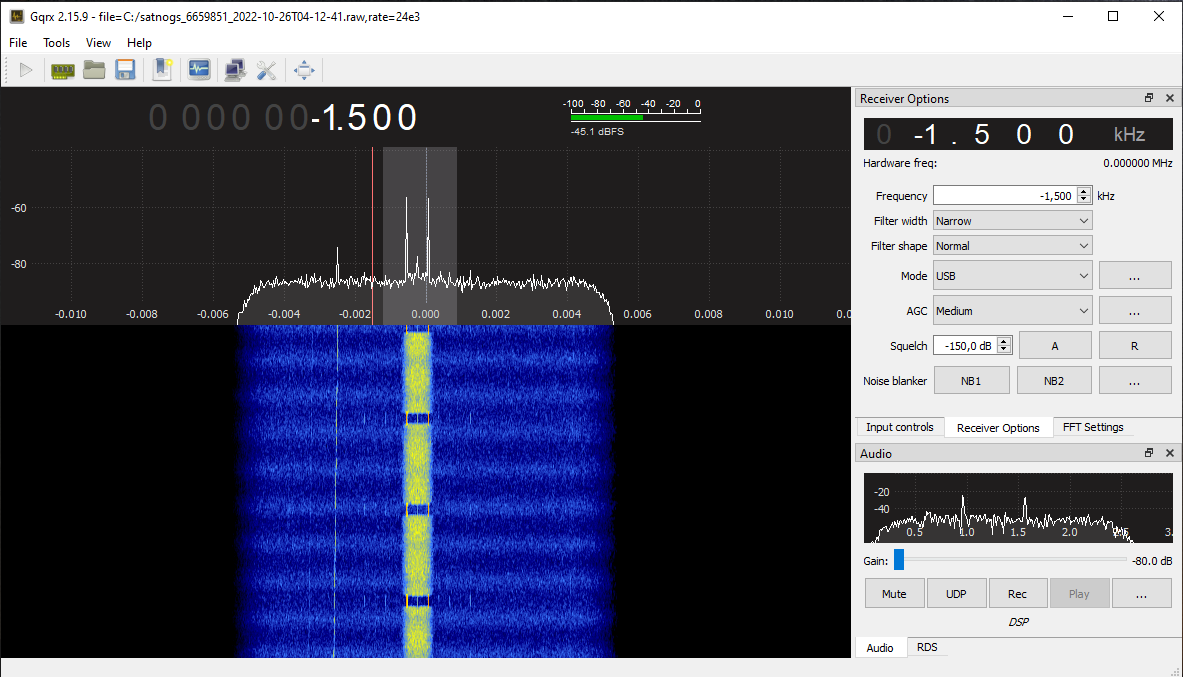Difference between revisions of "Wiki/Replay observations from audio"
(Create page) (Tag: Visual edit) |
|||
| Line 1: | Line 1: | ||
{{Message|This page is under construction.}} | {{Message|This page is under construction.}} | ||
| − | + | ==Background== | |
| + | Running a SatNOGS station enables you to save the IQ files and look at the observation with other tools, these are not available for download from the usual [https://network.satnogs.org/observations/ Observations] page. Some do publish these on their own cloud storage or available by request. The possibility to get these are quite limited on the vast majority of the stations. | ||
| + | |||
| + | The Audio files are usually quite narrow and the mode selected changes it's behavior, it can be hard to use it for signals wider/higher/lower than what the original mode has requested. | ||
| + | |||
| + | One of the modes that has some opportunities is the BPSK flowgraph. Downloading one of these audio files will grant you a decent slice of the spectrum offset to 12kHz up (if baud was higher than 1200), this opens up for further processing, but how to do it ? | ||
| + | |||
| + | ==Converting back audio to IQ== | ||
| + | |||
| + | Using our favorite SDR tools like [https://gqrx.dk/ gqrx], [https://www.sdrpp.org/ SDR++] etc will make it very easy to tune around and choose different modes, width etc, but they usually don't support this plain audio format. | ||
| + | |||
| + | Two methods have been tested successfully, both convert the audio file to a format these programs can use. This example uses [https://www.gnuradio.org/ gnuradio]-3.10, but 3.9 should also work just fine, 3.8 doesn't have OGG file support so you will have to convert it to WAV first. | ||
| + | |||
| + | Getting started in windows is usually a challenge for these tools so that is what this guide will address specifically, the package I used is [https://github.com/ryanvolz/radioconda/releases radioconda] and it includes gqrx and [https://gr-satellites.readthedocs.io/ gr-satellites] as well. | ||
| + | |||
| + | |||
| + | Lets start with the flowgraph itself, available for download [https://github.com/kng/satnogs_gr-satellites/tree/main/utils here] as wav2iq_raw.grc. | ||
| + | |||
| + | [[File:Wav2iq raw.png]] | ||
| + | |||
| + | Open the Wav File Source and browse to the ogg/wav you want to convert, then open File Sink and select the destination raw (you can copy the string from the wav source and just change the extension to .raw). Then simply run the flowgraph with the play button or F6. It should only take a few seconds to complete as indicated by a >>> Done. | ||
| + | |||
| + | In this example I'm going to use observation [https://network.satnogs.org/observations/6659851/ #6659851]. This has a audio file size of about 10MB and the resulting raw is almost 130MB, so one can understand why this is not uploaded to the network. | ||
| + | |||
| + | ==Opening RAW in gqrx== | ||
| + | |||
| + | Opening this file in gqrx is perhaps a bit cumbersome, but the dialog that appears on start is the Configure I/O devices, in this you will fill in a string formatted in this way: | ||
| + | <br>file=C:/exmple/satnogs_6659851_2022-10-26T04-12-41.raw,rate=24e3 | ||
| + | |||
| + | Note that the backslash is changed to forwardslash, and the rate at the end is the sample rate of the raw, in this case 24000 sps. | ||
| + | |||
| + | [[File:Gqrx configure iodev.png]] | ||
| + | |||
| + | After it's opened you can go ahead and select the mode and frequency etc. | ||
| + | |||
| + | [[File:Gqrx funcube bpsk.png]] | ||
| + | |||
| + | |||
| + | {{Message|WIP WIP WIP}} | ||
Revision as of 18:25, 26 October 2022
Background
Running a SatNOGS station enables you to save the IQ files and look at the observation with other tools, these are not available for download from the usual Observations page. Some do publish these on their own cloud storage or available by request. The possibility to get these are quite limited on the vast majority of the stations.
The Audio files are usually quite narrow and the mode selected changes it's behavior, it can be hard to use it for signals wider/higher/lower than what the original mode has requested.
One of the modes that has some opportunities is the BPSK flowgraph. Downloading one of these audio files will grant you a decent slice of the spectrum offset to 12kHz up (if baud was higher than 1200), this opens up for further processing, but how to do it ?
Converting back audio to IQ
Using our favorite SDR tools like gqrx, SDR++ etc will make it very easy to tune around and choose different modes, width etc, but they usually don't support this plain audio format.
Two methods have been tested successfully, both convert the audio file to a format these programs can use. This example uses gnuradio-3.10, but 3.9 should also work just fine, 3.8 doesn't have OGG file support so you will have to convert it to WAV first.
Getting started in windows is usually a challenge for these tools so that is what this guide will address specifically, the package I used is radioconda and it includes gqrx and gr-satellites as well.
Lets start with the flowgraph itself, available for download here as wav2iq_raw.grc.
Open the Wav File Source and browse to the ogg/wav you want to convert, then open File Sink and select the destination raw (you can copy the string from the wav source and just change the extension to .raw). Then simply run the flowgraph with the play button or F6. It should only take a few seconds to complete as indicated by a >>> Done.
In this example I'm going to use observation #6659851. This has a audio file size of about 10MB and the resulting raw is almost 130MB, so one can understand why this is not uploaded to the network.
Opening RAW in gqrx
Opening this file in gqrx is perhaps a bit cumbersome, but the dialog that appears on start is the Configure I/O devices, in this you will fill in a string formatted in this way:
file=C:/exmple/satnogs_6659851_2022-10-26T04-12-41.raw,rate=24e3
Note that the backslash is changed to forwardslash, and the rate at the end is the sample rate of the raw, in this case 24000 sps.
After it's opened you can go ahead and select the mode and frequency etc.


